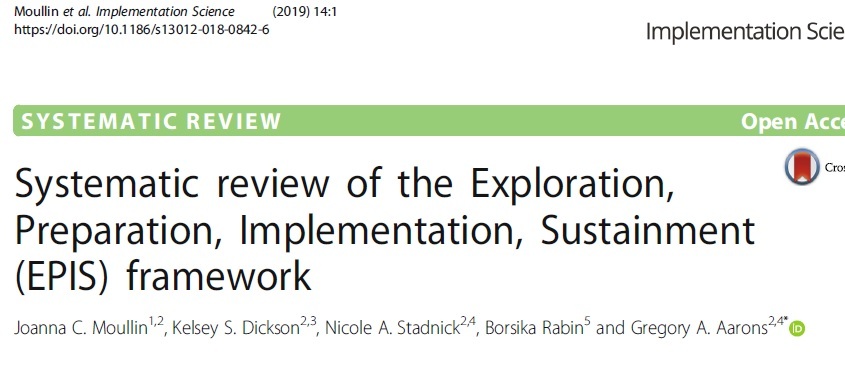The EPIS Implementation Framework
Welcome to the Exploration, Preparation, Implementation, Sustainment (EPIS) Website! This site was created to explain and support the EPIS Framework and provides resources for using EPIS including measures and tools (e.g., worksheets, guides).
The EPIS Framework highlights key phases that guide and describe the implementation process and enumerates common and unique factors within and across levels of outer context (system) and inner (organizational) context across phases, factors that bridge outer and inner context, and the nature of the innovation or practice being implemented and the role of innovation/practice developers.
This site is continually being developed and improved. Please send us your comments and suggestions using the “Contact Us” link.
________________________________________________________________________________________________________
In the literature
________________________________________________________________________________________________________
This 2019 paper published in Implementation Science provides real world examples of ways to use a framework to guide and test theory and process, and lists measures for many EPIS constructs. This review illustrates the broad application of EPIS across different countries, health systems, and health problems. We recommend deep/comprehensive meaningful use of frameworks for research and practice.
_______________________________________________________________________________________________________
This 2011 paper published in Administration and Policy in Mental Health describes the EPIS model and its use in public sector services.
_________________________________________________________________________________________________________
In this Research Webinar Series provided by the National Cancer Institute, Dr. Gregory Aarons explains the EPIS Framework.
The Four Phases of EPIS
EPIS describes four well-defined phases that align with and guide the implementation process, identification of levels within and across outer system and inner organizational contexts, and bridging and innovation factors that have to do with the the interplay of outer and inner context, and the innovation or practice being implemented.
In the Exploration phase, a service system, organization, research group, or other stakeholder(s) consider the emergent or existing health needs of the patients, clients, or communities and work to identify the best EBP(s) to address those needs, and subsequently decides whether to adopt the identified EBP.
In the Preparation phase, the primary objectives are to identify potential barriers and facilitators of implementation at the outer and inner contexts (described later), further assess needs for adaptation, and to develop a detailed plan to capitalize on implementation facilitators and address potential barriers.
In the Implementation phase, EBP use is initiated and instantiated in the system and/or organization(s).
In the Sustainment phase, the outer and inner context structures, processes, and supports are ongoing so that the EBP continues to be delivered, with or without some adaptation, to realize the resulting public health impact of the implemented EBP.




